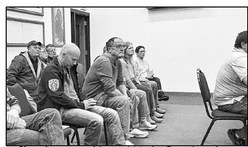Bollard


A small mob of bollards has sprung up in the corner of my driveway.
Well, more accurately bollard-like or perhaps bollardadjacent, structures.
No, these are not some weird plant growth, or avantgarde interpretive art installation. Nor am I intending to use them to make any sort of visual call for help about feeling caged in by the less than stellar weather and longing for the freedom of summer.
No, they have a much more practical purpose. Among functional civic architectural terms, the word bollard is perhaps the one that is the most fun to say. I think it is because something about it sounds like language that your mother would reprimand you using for being impolite and not the sort that should be used in mixed company.
Something about the word bollard, just rolls off the tongue and is far more satisfying to say as part of an insult than one of those crass 4-letter pejoratives.
Imagine someone yelling “You bollard!” or describing someone as being “Bollard-like in their brilliance.”
I assure you those sounded brilliant to me when I was wide awake at 3 a.m. the other night staring at my ceiling fan and trying to remember if it was time to switch it from sucking air up toward the ceiling or blowing it down. I know you are supposed to switch it between summer and winter, but I can never remember which and generally only remember to worry about it when I wake up in the middle of the night and can’t get back to sleep.
Oh bollard. See, bollard works nicely in place of more rude language.
Beyond being a fun word to say, bollards are practical and commonplace. You probably have passed several today without even noticing.
Officially, bollards are short sturdy vertical posts. The word origin is believed to come from the bole or trunk of a tree.
The term initially had a nautical reference as posts to a play for tying up boats and docks and keeping them secure. Beyond the docks, bollards are used to control road traffic and prevent access.
At the Medford Area Elementary School a row of bright yellow bollards separates the parking lot from the driveway leading to the school. Bollards are also common to have in front of the entrances of shopping centers with the goal of stopping vehicles from becoming battering rams to take down the front doors. You also see them separating pedestrian areas, and there are even fancy retractable robotic bollards used in big cities for security or to close off vehicular traffic during special events.
My bollard-like masterpieces are not nearly as exciting as those, nor will they likely ever be used to stop anything beyond an errant gust of wind.
Canopy tents are great things for providing shade from the sun or protection from the rain. However, unless properly secured, they can become giant kites. Despite what you might think, chasing down a canopy on a gusty day is not a fun activity. While ideally you would drive stakes into the ground to secure canopy tents, this is not always possible leading to the use of weights.
There are all sorts of commercially available weights of various sizes and shapes, and plenty of home-made options.
During the Kiwanis Summer Concert Series last year we repurposed gallon jugs and filled them with sand. They worked OK, but the plastic quickly degraded and they would need to be replaced every year.
After doing some research, I decided to make some bollard-like weights out of lengths of PVC pipe filled with concrete with an eye-bolt embedded in the concrete on the top. I used 4-inch PVC for my first set and made five of them that way. Last weekend, I finished the second five using three-inch PVC.
My daughter thinks I should spray paint them a nice Kiwanis blue. For now, they are standing in my driveway quietly curing and pretending to be bollards.
Brian Wilson is News Editor at The Star News. Contact Brian at BrianWilson@centralwinews.com.




